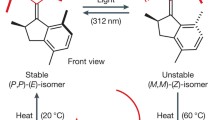Abstract.
Technology is omnipresent in our modern-day society and it is hard to imagine a world without machines, computers or robots. One of the main current scientific challenges is the bottom-up construction of systems that represent nanosize analogues of switches, devices and motors. Our efforts in this area have focussed on the construction of devices based on sterically overcrowded alkenes. In this paper, we present our ongoing research on the construction of binary molecular switches, which has recently led to genuine molecular motors. The control of chirality in a molecular switching system allows interconversion between molecules of opposite helicity using different wavelengths of light. Such bistable chiral switches are of potential use in optical data storage and processing at the molecular level. The control of molecular chirality is even more subtle in the case of molecular motor systems. The exquisite control of chirality using light as an energy source has resulted in a controlled, repetitive 360° unidirectional rotation in two generations of molecular motor systems.
Similar content being viewed by others
Author information
Authors and Affiliations
Additional information
Received: 21 January 2002 / Accepted: 11 February 2002 / Published online: 22 April 2002
Rights and permissions
About this article
Cite this article
Feringa, B., Koumura, N., van Delden, R. et al. Light-driven molecular switches and motors . Appl Phys A 75, 301–308 (2002). https://doi.org/10.1007/s003390201338
Published:
Issue Date:
DOI: https://doi.org/10.1007/s003390201338




